Instruction
How to Fix Your Yips with Feedback
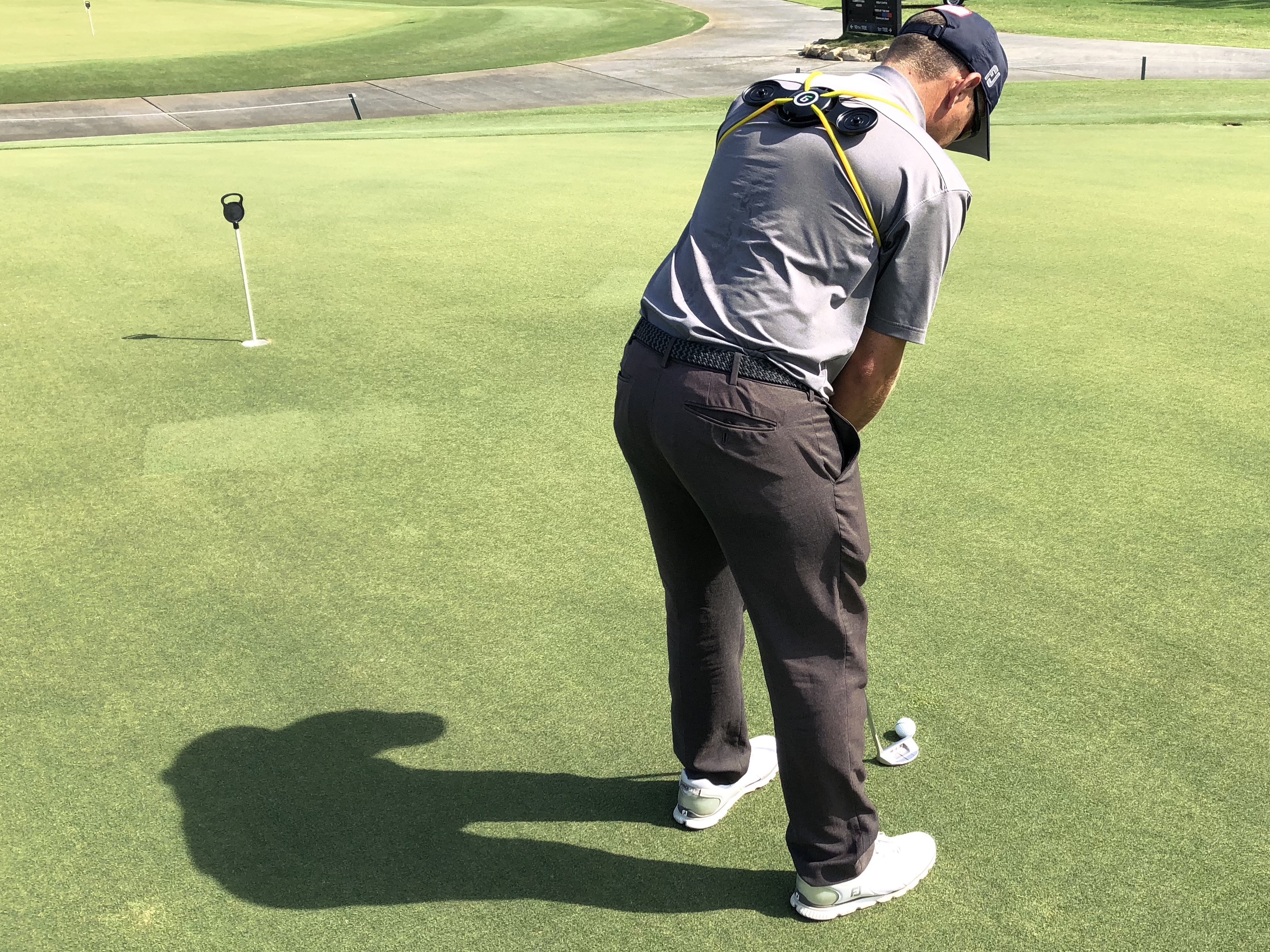
Much has been written about the putting yips over the years, with many different proposed explanations. They have been attributed to nerves, anxiety, focal dystonia and even, as Tommy Armour famously put it: “a brain spasm that impairs the short game.”
While the true source of the putting yips remains unknown, what it looks like is very obvious. It’s for that reason — and my lack of neurological training — that I’ll be focusing on the mechanical side of the problem that plagues so many people.
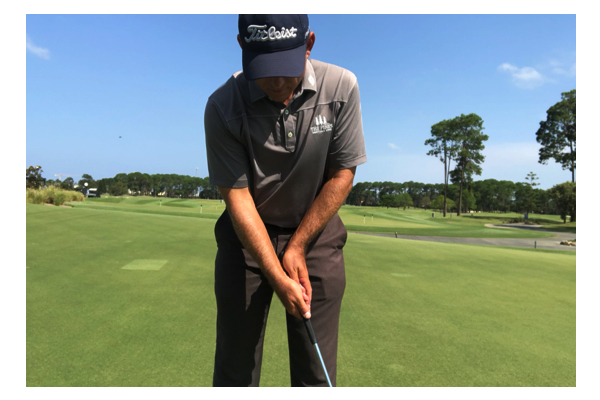
Classic yip stroke movement
Explanation
What we see here is lead wrist extension and trail wrist flexion. Simply put, the bottom hand takes over the stroke with three main disastrous effects for control of the putter face.
- Adds too much loft. Basically, the ball gets slightly airborne straight off the putter face. This compromises the ball roll and changes dynamic launch angle, creating unnecessary backspin. All putters have a small amount of loft built into the design (typically 2-4 degrees) to help lift the ball out of the depression that it sits in on the green, so there is no need to add more loft with your putting stroke.
- Toe moves faster than heel. This causes the putter face to close at a rapid rate, leading to pulls or pushes due to the extra timing involved in attempt to square up the club face.
- Off-center strike. I also see yippers actually missing the center of the club face more often than not. The same aggressive rise angle of the putter that adds loft can also produce a putt that strikes the ball below the vertical sweet spot on the putter. The subsequent loss in ball energy makes direction and speed issues inevitable.
So we have a trio of unwanted outcomes from this simple fault; the ball jumping off the face and heading left or right with unpredictable speed — not a great formula for holing putts!
We know that for putts to go in the hole, they need to be hit on the correct line with the associated correct speed. Putting is hard and there are narrow margins for success. A positive outcome is a lot less likely with a yippy stroke. What often makes things worse is when the yipper knows the yip is coming, and he or she attempts to compensate for it. That appears to have happened to Ernie Els when missing this tiddler:
With the anchoring of putters now banned in competitive play, our plausible alternatives are limited to the cross-hand grip, claw grip or some other variation or differing style that aims to reduce the involvement of the wrist. The solution I am going to propose will allow you to keep your regular grip, but instead uses kinaesthetic (touch) feedback to encourage the correct movement.
Clarification
Before describing what I’m doing in the video above, it’s important to clarify what I feel should happen in a solid putting stroke. I like to see a slight forward press of the hands (if you have a putter with any offset configuration, as most do) with less extension in the lead wrist and more extension in the trail wrist, as demonstrated below.
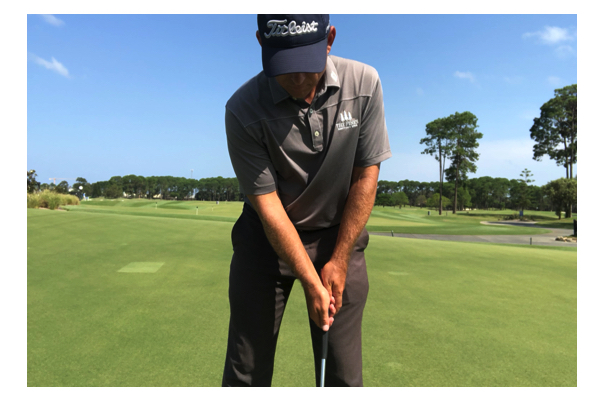
Hands set slightly ahead of the putter head
From there, I like to see the movement be driven by the rotation of the t-spine (trunk or thorax) as the dominant source of motion as opposed to wrist, elbow or shoulder movement. I feel like many yippers get into trouble from the start with poor posture, hands behind the ball and with a backstroke that is too high. Then we see the classic move into impact as the body stalls and the wrists take over.
Demonstration of an (exaggerated) yippy stroke
Solution
Back to the video of me hitting a putt with the bands. The device I’m using is called a GravityFit TPro, and it performs three really useful functions. First, it gives me feedback as to whether I’m in good posture. I believe that having a properly organized spine and shoulder blade position is critical to making a good stroke driven from rotation of the t-spine.
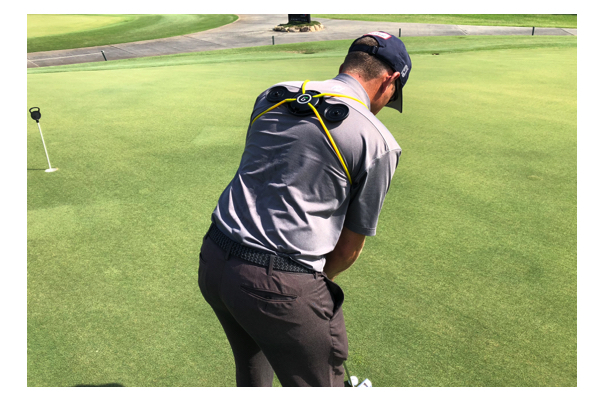
Posture and Movement Feedback
The second benefit I get from the equipment is the feedback on whether I’ve made the movement correctly. If the body stalls out and hands or arms take over, I will lose connection of my shoulder blades with the paddles on either side. It’s like a closed feedback loop, constantly telling me if I’m doing a good job or not with my rotation.
The third function involves the bands. As you can see in the photo below, I loop these around the thumb of the left hand and over the palm of the right hand. This actually wants to pull my left hand in to flexion and right in to extension, which we know is the opposite of what happens when we make a yippy stroke.

Resistance bands encouraging hands to set better
So now I’m being told if my posture is set right, if I’m rotating properly and I’ve got anti-yip guidance from the bands. My recommendation is do plenty of reps using the TPro away from the golf course, perhaps at home in your living room. When you go to the putting green, start off by hitting 10-15 footers to no target in particular to adjust to the different feels and get used to getting a quality strike. Then slowly make your way to the dreaded short putt range and calmly knock them in.
Like anything that involves a change in technique, it’s going to take a few reps to make a difference. The beauty of using the TPro is you can do it at home — with or without a putter. It’s also going to have a useful side effect of improving your posture, which most of us could benefit from!
For more info on my short game coaching services, drop me an email: [email protected]
- LIKE29
- LEGIT3
- WOW1
- LOL2
- IDHT2
- FLOP4
- OB6
- SHANK49
Instruction
The Wedge Guy: The easiest-to-learn golf basic

My golf learning began with this simple fact – if you don’t have a fundamentally sound hold on the golf club, it is practically impossible for your body to execute a fundamentally sound golf swing. I’m still a big believer that the golf swing is much easier to execute if you begin with the proper hold on the club.
As you might imagine, I come into contact with hundreds of golfers of all skill levels. And it is very rare to see a good player with a bad hold on the golf club. There are some exceptions, for sure, but they are very few and very far between, and they typically have beat so many balls with their poor grip that they’ve found a way to work around it.
The reality of biophysics is that the body moves only in certain ways – and the particulars of the way you hold the golf club can totally prevent a sound swing motion that allows the club to release properly through the impact zone. The wonderful thing is that anyone can learn how to put a fundamentally sound hold on the golf club, and you can practice it anywhere your hands are not otherwise engaged, like watching TV or just sitting and relaxing.
Whether you prefer an overlap, interlock or full-finger (not baseball!) grip on the club, the same fundamentals apply. Here are the major grip faults I see most often, in the order of the frequency:
Mis-aligned hands
By this I mean that the palms of the two hands are not parallel to each other. Too many golfers have a weak left hand and strong right, or vice versa. The easiest way to learn how to hold the club with your palms aligned properly is to grip a plain wooden ruler or yardstick. It forces the hands to align properly and shows you how that feels. If you grip and re-grip a yardstick several times, then grip a club, you’ll see that the learning curve is almost immediate.
The position of the grip in the upper/left hand
I also observe many golfers who have the butt of the grip too far into the heel pad of the upper hand (the left hand for right-handed players). It’s amazing how much easier it is to release the club through the ball if even 1/4-1/2″ of the butt is beyond the left heel pad. Try this yourself to see what I mean. Swing the club freely with just your left hand and notice the difference in its release from when you hold it at the end of the grip, versus gripping down even a half inch.
To help you really understand how this works, go to the range and hit shots with your five-iron gripped down a full inch to make the club the same length as your seven-iron. You will probably see an amazing shot shape difference, and likely not see as much distance loss as you would expect.
Too much lower (right) hand on the club
It seems like almost all golfers of 8-10 handicap or higher have the club too far into the palm of the lower hand, because that feels “good” if you are trying to control the path of the clubhead to the ball. But the golf swing is not an effort to hit at the ball – it is a swing of the club. The proper hold on the club has the grip underneath the pad at the base of the fingers. This will likely feel “weak” to you — like you cannot control the club like that. EXACTLY. You should not be trying to control the club with your lower/master hand.
Gripping too tightly
Nearly all golfers hold the club too tightly, which tenses up the forearms and prevents a proper release of the club through impact. In order for the club to move back and through properly, you must feel that the club is controlled by the last three fingers of the upper hand, and the middle two fingers of the lower hand. If you engage your thumbs and forefingers in “holding” the club, the result will almost always be a grip that is too tight. Try this for yourself. Hold the club in your upper hand only, and squeeze firmly with just the last three fingers, with the forefinger and thumb off the club entirely. You have good control, but your forearms are not tense. Then begin to squeeze down with your thumb and forefinger and observe the tensing of the entire forearm. This is the way we are made, so the key to preventing tenseness in the arms is to hold the club very lightly with the “pinchers” — the thumbs and forefingers.
So, those are what I believe are the four fundamentals of a good grip. Anyone can learn them in their home or office very quickly. There is no easier way to improve your ball striking consistency and add distance than giving more attention to the way you hold the golf club.
More from the Wedge Guy
- The Wedge Guy: Golf mastery begins with your wedge game
- The Wedge Guy: Why golf is 20 times harder than brain surgery
- The Wedge Guy: Musings on the golf ball rollback
- LIKE83
- LEGIT13
- WOW5
- LOL1
- IDHT0
- FLOP4
- OB1
- SHANK8
Instruction
Clement: Stop ripping off your swing with this drill!

Not the dreaded headcover under the armpit drill! As if your body is defective and can’t function by itself! Have you seen how incredible the human machine is with all the incredible feats of agility all kinds of athletes are accomplishing? You think your body is so defective (the good Lord is laughing his head off at you) that it needs a headcover tucked under the armpit so you can swing like T-Rex?
- LIKE0
- LEGIT2
- WOW2
- LOL0
- IDHT0
- FLOP0
- OB0
- SHANK2
Instruction
How a towel can fix your golf swing

This is a classic drill that has been used for decades. However, the world of marketed training aids has grown so much during that time that this simple practice has been virtually forgotten. Because why teach people how to play golf using everyday items when you can create and sell a product that reinforces the same thing? Nevertheless, I am here to give you helpful advice without running to the nearest Edwin Watts or adding something to your Amazon cart.
For the “scoring clubs,” having a solid connection between the arms and body during the swing, especially through impact, is paramount to creating long-lasting consistency. And keeping that connection throughout the swing helps rotate the shoulders more to generate more power to help you hit it farther. So, how does this drill work, and what will your game benefit from it? Well, let’s get into it.
Setup
You can use this for basic chip shots up to complete swings. I use this with every club in my bag, up to a 9 or 8-iron. It’s natural to create incrementally more separation between the arms and body as you progress up the set. So doing this with a high iron or a wood is not recommended.
While you set up to hit a ball, simply tuck the towel underneath both armpits. The length of the towel will determine how tight it will be across your chest but don’t make it so loose that it gets in the way of your vision. After both sides are tucked, make some focused swings, keeping both arms firmly connected to the body during the backswing and follow through. (Note: It’s normal to lose connection on your lead arm during your finishing pose.) When you’re ready, put a ball in the way of those swings and get to work.

Get a Better Shoulder Turn
Many of us struggle to have proper shoulder rotation in our golf swing, especially during long layoffs. Making a swing that is all arms and no shoulders is a surefire way to have less control with wedges and less distance with full swings. Notice how I can get in a similar-looking position in both 60° wedge photos. However, one is weak and uncontrollable, while the other is strong and connected. One allows me to use my larger muscles to create my swing, and one doesn’t. The follow-through is another critical point where having a good connection, as well as solid shoulder rotation, is a must. This drill is great for those who tend to have a “chicken wing” form in their lead arm, which happens when it becomes separated from the body through impact.
In full swings, getting your shoulders to rotate in your golf swing is a great way to reinforce proper weight distribution. If your swing is all arms, it’s much harder to get your weight to naturally shift to the inside part of your trail foot in the backswing. Sure, you could make the mistake of “sliding” to get weight on your back foot, but that doesn’t fix the issue. You must turn into your trial leg to generate power. Additionally, look at the difference in separation between my hands and my head in the 8-iron examples. The green picture has more separation and has my hands lower. This will help me lessen my angle of attack and make it easier to hit the inside part of the golf ball, rather than the over-the-top move that the other picture produces.


Stay Better Connected in the Backswing
When you don’t keep everything in your upper body working as one, getting to a good spot at the top of your swing is very hard to do. It would take impeccable timing along with great hand-eye coordination to hit quality shots with any sort of regularity if the arms are working separately from the body.
Notice in the red pictures of both my 60-degree wedge and 8-iron how high my hands are and the fact you can clearly see my shoulder through the gap in my arms. That has happened because the right arm, just above my elbow, has become totally disconnected from my body. That separation causes me to lift my hands as well as lose some of the extension in my left arm. This has been corrected in the green pictures by using this drill to reinforce that connection. It will also make you focus on keeping the lead arm close to your body as well. Because the moment either one loses that relationship, the towel falls.


Conclusion
I have been diligent this year in finding a few drills that target some of the issues that plague my golf game; either by simply forgetting fundamental things or by coming to terms with the faults that have bitten me my whole career. I have found that having a few drills to fall back on to reinforce certain feelings helps me find my game a little easier, and the “towel drill” is most definitely one of them.
- LIKE12
- LEGIT2
- WOW2
- LOL0
- IDHT0
- FLOP2
- OB0
- SHANK8
-

 19th Hole2 weeks ago
19th Hole2 weeks agoJohn Daly stuns fans into silence with brutal opening tee shot on PGA Tour Champions
-

 19th Hole6 days ago
19th Hole6 days agoThings got heated at the Houston Open between Tony Finau and Alejandro Tosti. Here’s why
-

 19th Hole3 days ago
19th Hole3 days agoReport: Tiger Woods has ‘eliminated sex’ in preparation for the 2024 Masters
-

 19th Hole2 weeks ago
19th Hole2 weeks ago2-time major champ announces shock retirement from the sport at age of 33
-

 19th Hole3 weeks ago
19th Hole3 weeks agoEdoardo Molinari reveals the latest PGA Tour golfer to turn down ‘good offer’ from LIV Golf
-

 19th Hole2 weeks ago
19th Hole2 weeks agoCharlie Woods finds it tough going on American Junior Golf Association debut
-

 19th Hole3 weeks ago
19th Hole3 weeks agoScottie Scheffler had an interesting response when asked how he ‘quiets the noise’ following Players victory
-

 19th Hole5 days ago
19th Hole5 days agoAddiction, spinal fusion, and scam artists – Everything Anthony Kim revealed in candid interview with David Feherty











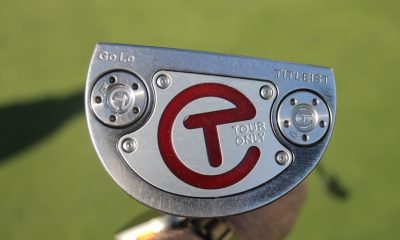

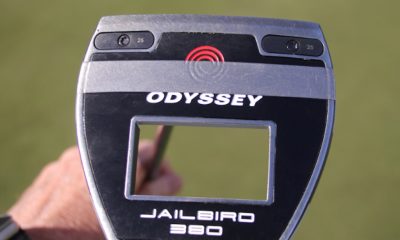

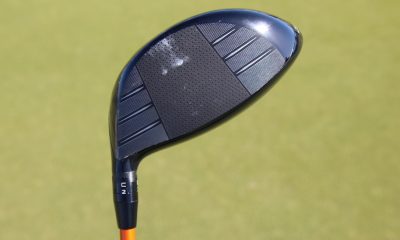



Mark Hartig
Mar 6, 2018 at 3:29 pm
I developed the yips in 1999. Tried EVERYTHING, including – 18 years before this video by Mr. Randall – and nothing worked.
On an annual “buddy trip” to Sarasota, FL, my putting stroke was so poor that one friend whispered to another, “OK, what is he setting me up for?”
My friend replied, “Nothing!! When I picked him up at the airport, he told me he had the yips, but I had no idea it was this bad.”
Finally, after angrilly ripping a divot from the 15th green, I did something (yip cure-hope #101!) I had never done before. Whaah Laaah!! The yips were gone – IMMEDIATELY!! And the yips have never, even in the slightest of measure – returned to haunt me again.
It is my hope to contact Mr. Randall to discus a collaberation!
Steve S
Mar 3, 2018 at 12:46 am
This article may or may not fix the yips but it definitely saved Mr. Randall some advertising dollars.
Bruce Rearick
Mar 1, 2018 at 10:56 am
This is great advice. He is changing the motor pattern from hands and arms to big muscle/ core movement. The device enhances the feel of the new pattern. It also promotes a truer rotation of the putter along the stroke plane. Many yippers start with rotational problems. I understand the frustration of those who have the issues, but I wouldn’t be so quick to give up on this concept.
Mark
Feb 28, 2018 at 6:22 pm
I Cannot believe you allowed this article to be published!
Sam Robey
Feb 28, 2018 at 10:41 am
The author of this article has obviously never had the yips and has no idea what he’s talking about. It’s a neurological issue. That’s why changing the motor pattern offers such a quick and lasting fix.
juliette
Feb 28, 2018 at 5:47 pm
While the author meant well with possibly a financial motive too, the only scientific yips study at the Mayo Clinic in Rochester, NY concluded that the yips is indeed some kind of neurological misfiring–and attributed that to focal dystonia. On the other hand many physical fixes have helped people with the yips so I can’t discount this attempt. The physical fix really just opens a new pathway to the brain that creates a new circuit to replace the damaged yippy one. It’s still an anxiety problem.
Maybe doing some or all of these things will be so foreign to some yippers that this new circuitry will help reduce their yips. But without that dynamic (Hank Haney said that he “cured” his driving yips by staring at the inside brim of his golf hat while swinging!!—try that for maintaining balance much less knowing where the heck the ball is) this does not address the yip problem at all.
If the author is saying this will address the problem then I’m afraid to say it’s utter nonsense.
juliette
Feb 28, 2018 at 5:50 pm
Fwiw to bolster my comment I have had the driving, chipping and putting yips for decades, on and off again with driving (within a round, not years apart), chipping (off now for two years) and putting (completely gave up on putting LH and switched to putting RH where I do not yip at all…)
juliette
Feb 28, 2018 at 7:45 pm
One other thing…this article probably should not have been published because it’s like an article professing to explain why the Earth is flat. You cannot prove a premise that is known to be false by all who study and understand this issue. The more I think about it the more incensed I am that this kind of article is not filtered more critically by wrx staffers. Yeah, people who yip hold out all kinds of hope but this is not a physical address or alignment problem. Too many people at too high a level of golfing skills come down with this and all of them do not have alignment and address problems. That is just nuts. Oh yeah, what would Ben Hogan say about this guy telling him his alignment and address positions were just off. Wouldn’t be pretty…
Greg V
Feb 28, 2018 at 10:13 am
I developed the yips in my 30’s. I could have given up the game, but I enjoy hitting a golf ball. The best that I have putted since then was with a claw grip on a belly putter. These days I resort to the claw grip on a regular putter. As some famous pro once said, when you got ’em, you got ’em. For awhile I actually putted clasping the grip against my left arm, like Langer did originally. I had them playing squash as well, when I would attempt a soft drop shot with the forehand. Same problem – right hand spasm.
I think that if you have never had them, you have no idea of what you are talking about in relation to helping someone who actually has them.